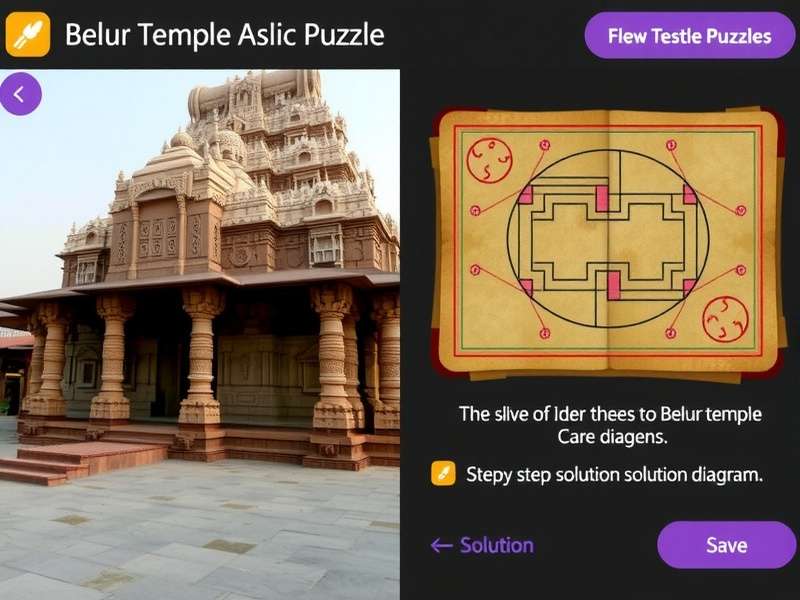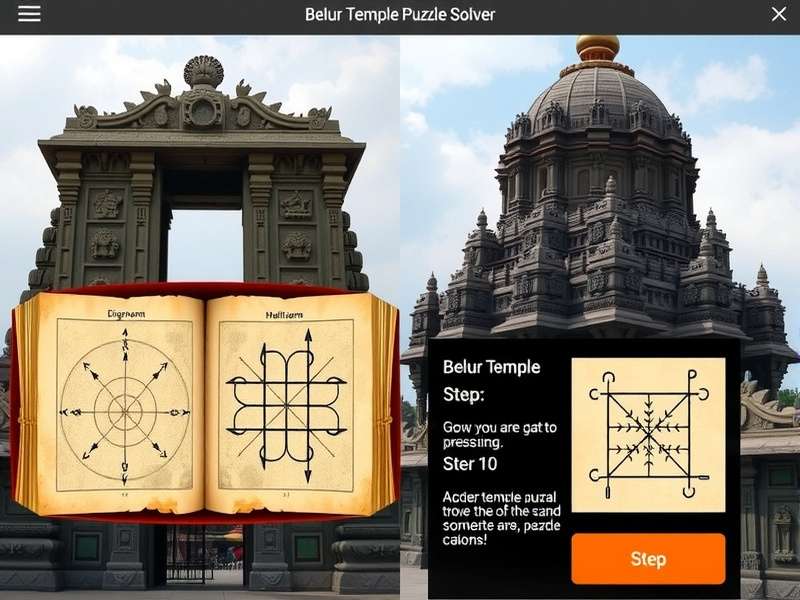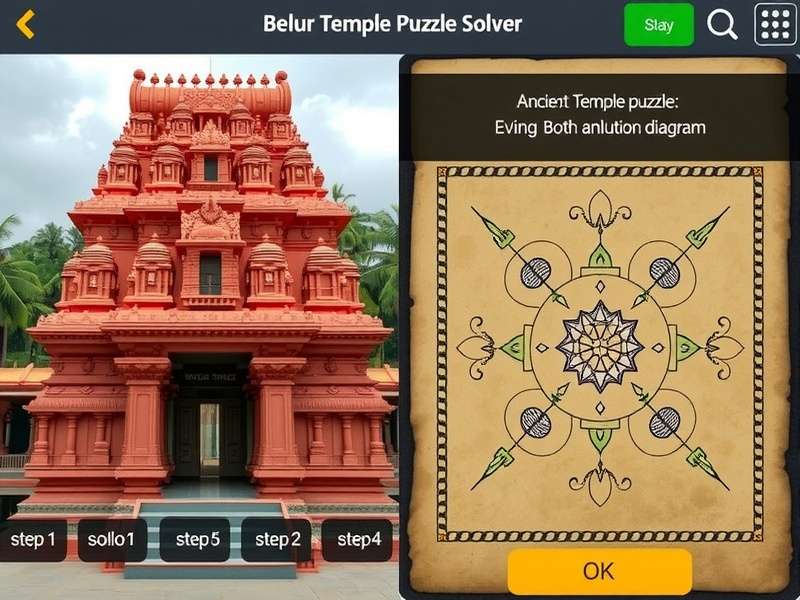Table of Contents
Belur Temple Puzzle Solver: Complete Encyclopedia

Overview of Belur Temple Puzzle Solver
TheBelur Temple Puzzle Solverrepresents one of India's most fascinating intellectual traditions, originating from the magnificent Hoysala architecture of Karnataka. This ancient puzzle game combines mathematical precision with spiritual symbolism, creating a unique challenge that has captivated minds for centuries. TheBelur Temple Puzzle Solverapproach involves systematic problem-solving techniques that mirror the intricate carvings found throughout the temple complex.
What makes theBelur Temple Puzzle Solverparticularly remarkable is its multidimensional nature. Unlike Western puzzle traditions that often focus solely on logical sequences, this Indian masterpiece integrates spatial reasoning, numerical patterns, and symbolic interpretation. The game's complexity stems from its foundation in Vedic mathematics and temple architecture principles, creating layers of challenge that require both analytical and intuitive thinking.
Key Characteristics ✨
- Originates from 12th century Hoysala Empire temple architecture
- Combines mathematical patterns with spiritual symbolism
- Requires multidimensional thinking and spatial reasoning
- Based on ancient Indian mathematical principles
- Has both physical and abstract solving approaches
Historical Background & Origins
The historical roots of theBelur Temple Puzzle Solvertrace back to the glorious Hoysala period (1026–1343 CE), specifically during the construction of the Chennakesava Temple in Belur. This magnificent structure, commissioned by King Vishnuvardhana in 1117 CE, features some of the most sophisticated stone carvings and architectural puzzles in Indian history. The temple artisans developed these puzzles as both entertainment and educational tools for temple scholars.
Historical records indicate that the originalBelur Temple Puzzle Solverchallenges were used to test mathematical aptitude and logical reasoning among temple priests and scholars. These intellectual exercises were considered essential training for understanding complex Vedic texts and performing precise astronomical calculations. The puzzles were intricately carved into temple pillars and walls, serving both decorative and pedagogical purposes.

During the Vijayanagara Empire period, theBelur Temple Puzzle Solvertradition expanded beyond temple walls and became popular among royal courts and educational institutions. Traveling scholars would demonstrate their intellectual prowess by solving these puzzles, and competitions were often held during religious festivals. The British colonial period saw documentation of these puzzles by Orientalists, though their mathematical sophistication was often underestimated by Western scholars at the time.
Archaeological Evidence 🔍
Modern archaeological studies have revealed multiple layers of puzzle complexity within the Belur Temple complex. The most sophisticated challenges are found in the navaranga (hall) area, where intricate geometric patterns form the basis for advanced mathematical puzzles. These discoveries have led to renewed interest in theBelur Temple Puzzle Solvermethodology among mathematicians and computer scientists studying ancient computational systems.
Game Rules & Mechanics
The traditionalBelur Temple Puzzle Solverfollows a structured set of rules that balance mathematical precision with creative problem-solving. The basic game involves arranging a set of carved stone pieces or symbolic tokens according to specific patterns derived from temple architecture. The objective is to recreate sacred geometric formations while adhering to mathematical constraints.
Core Game Mechanics 🎯
- Players must arrange pieces to form mandala-like patterns
- Each piece has specific mathematical properties and movement rules
- Solutions must satisfy both geometric and numerical conditions
- Multiple solution paths exist, with varying difficulty levels
- Advanced versions incorporate temporal and sequential constraints
The fundamental rules of theBelur Temple Puzzle Solverderive from Vedic mathematical principles, particularly those related to geometric progression, number theory, and spatial relationships. Each puzzle piece corresponds to mathematical concepts such as prime numbers, Fibonacci sequences, or sacred geometric ratios. The movement restrictions mirror traditional Indian board games while incorporating temple architectural principles.
Advanced Rule Variations
Beyond the basic mechanics, theBelur Temple Puzzle Solverincludes numerous advanced variations that increase complexity. These include temporal constraints where solutions must be completed within specific time frames, collaborative versions requiring multiple participants, and symbolic interpretations where mathematical solutions must align with philosophical or spiritual concepts. The most challenging variations incorporate astronomical alignments and seasonal calculations.
Solving Strategies & Techniques
Mastering theBelur Temple Puzzle Solverrequires developing sophisticated problem-solving strategies that combine analytical thinking with pattern recognition. Traditional approaches emphasize the importance of understanding foundational mathematical principles before attempting complex puzzles. Modern computational analysis has revealed that these ancient strategies often align with contemporary algorithmic thinking.

Traditional Solving Approaches
The classical methodology for theBelur Temple Puzzle Solverbegins with systematic observation and pattern identification. Experienced players first analyze the overall structure and identify key mathematical relationships between pieces. This initial assessment phase is crucial for developing an effective solving strategy. Traditional teachings emphasize the importance of patience and contemplation during this stage.
Intermediate strategies involve breaking down complex puzzles into manageable subsystems, solving each component before integrating them into the complete solution. This modular approach reflects the architectural principles of the Belur Temple itself, where complex structures are built from carefully designed individual elements. Advanced practitioners develop intuitive pattern recognition that allows them to identify solution pathways more rapidly.
Modern Computational Approaches 💻
Contemporary researchers have developed algorithmic approaches to theBelur Temple Puzzle Solverthat combine traditional wisdom with computer science. These include backtracking algorithms, constraint satisfaction programming, and neural network pattern recognition. Surprisingly, many ancient solving techniques parallel modern computational concepts, demonstrating the advanced mathematical thinking of the original puzzle designers.
Mathematical Foundations
The mathematical sophistication of theBelur Temple Puzzle Solverrepresents one of the most advanced intellectual achievements of medieval India. Based on principles from Vedic mathematics, the puzzles incorporate concepts that wouldn't be formally developed in Western mathematics for centuries. The foundation lies in intricate number theory, geometric transformations, and combinatorial mathematics.
Number Theory Applications
At its core, theBelur Temple Puzzle Solveremploys sophisticated number theory concepts including modular arithmetic, prime number distributions, and Diophantine equations. The puzzle arrangements often represent visual manifestations of numerical patterns described in ancient Indian mathematical texts. Solutions frequently require understanding of concepts like magic squares, Latin squares, and other combinatorial designs that were advanced for their time.
The geometric aspects of theBelur Temple Puzzle Solverdemonstrate remarkable understanding of spatial mathematics. Puzzles incorporate principles of symmetry groups, tessellations, and transformational geometry that anticipate modern mathematical concepts. The intricate stone carvings that inspired these puzzles exhibit mathematical precision in their proportions and spatial relationships, creating a perfect bridge between art and mathematics.
Computational Complexity
Modern analysis has revealed that some variations of theBelur Temple Puzzle Solverrepresent NP-hard problems, meaning they are computationally intensive to solve completely. This mathematical sophistication indicates that the original designers had intuitive understanding of computational concepts that wouldn't be formally defined until the 20th century. The puzzle's structure allows for both exact solutions and heuristic approaches, providing multiple pathways for solvers with different skill levels.
Cultural & Educational Significance
TheBelur Temple Puzzle Solverholds profound cultural significance in Indian intellectual history, representing a unique synthesis of spiritual, artistic, and mathematical traditions. Beyond its function as entertainment, the puzzle served important educational and philosophical purposes in traditional Indian society. It embodied the concept of "lila" (divine play) while developing essential cognitive skills.
Educational Applications 🎓
Historically, theBelur Temple Puzzle Solverwas used as an educational tool to develop mathematical reasoning, spatial intelligence, and problem-solving skills among temple scholars and royal court members. The progressive difficulty levels allowed for continuous intellectual development, from basic pattern recognition to advanced mathematical reasoning. Modern educators have rediscovered these benefits and are incorporating puzzle principles into STEM education.
The cultural impact of theBelur Temple Puzzle Solverextends beyond mathematics education. The puzzle embodies important philosophical concepts from Indian tradition, including the interconnectedness of all things, the relationship between microcosm and macrocosm, and the idea that complex systems emerge from simple rules. These philosophical dimensions add depth to the puzzle experience, transforming it from mere intellectual exercise to contemplative practice.
Preservation and Revival
In recent decades, there has been significant effort to preserve and revive theBelur Temple Puzzle Solvertradition. Cultural organizations, mathematical societies, and educational institutions have collaborated to document existing puzzle variations, reconstruct lost ones, and adapt the tradition for contemporary audiences. This revival movement recognizes the value of this intellectual heritage for both historical understanding and modern educational applications.
Modern Applications & Digital Versions
The transition of theBelur Temple Puzzle Solverinto the digital age has opened new possibilities for preservation, analysis, and accessibility. Computer scientists and game developers have created digital versions that maintain the mathematical integrity of the original while adding features impossible in physical form. These digital adaptations have introduced the puzzle to global audiences.

Digital Platform Features
Modern digital implementations of theBelur Temple Puzzle Solverinclude features such as interactive tutorials, progressive difficulty levels, solution tracking, and multiplayer capabilities. Some versions incorporate artificial intelligence assistants that provide hints based on traditional solving strategies. These digital platforms have made the puzzle accessible to people who cannot visit the physical temple, helping preserve this cultural treasure for future generations.
Beyond recreational applications, the principles of theBelur Temple Puzzle Solverhave found unexpected applications in modern technology. Computer scientists have drawn inspiration from the puzzle's efficient problem-solving approaches for algorithm design, particularly in constraint satisfaction and optimization problems. The puzzle's elegant mathematical structure has informed research in computational geometry and artificial intelligence.
Research and Development 🔬
Academic researchers continue to study theBelur Temple Puzzle Solverfrom multiple perspectives. Mathematicians analyze its underlying principles, computer scientists develop solving algorithms, historians document its evolution, and educators study its cognitive benefits. This multidisciplinary research ensures that this ancient intellectual tradition continues to contribute to modern knowledge across multiple fields.
Comparison With Other Puzzle Games
TheBelur Temple Puzzle Solveroccupies a unique position in the global landscape of traditional puzzle games. While sharing some characteristics with other ancient puzzles, it demonstrates distinctive features that reflect its cultural and mathematical origins. Understanding these comparisons helps illuminate what makes this puzzle tradition special and valuable.
Similarities With Western Puzzles
Superficially, theBelur Temple Puzzle Solvershares some characteristics with Western puzzle traditions like tangrams, sliding puzzles, and mechanical disentanglement puzzles. However, the mathematical foundation and philosophical dimensions of the Indian puzzle create a fundamentally different experience. While Western puzzles often prioritize efficiency and direct solutions, the Belur approach values contemplation and multiple solution pathways.
TheBelur Temple Puzzle Solvershows interesting parallels with other Asian puzzle traditions, particularly Chinese tangrams and Japanese puzzle boxes. However, its mathematical sophistication exceeds these traditions in specific areas, particularly in its integration of number theory and spatial reasoning. The temple puzzle's connection to architectural principles and spiritual concepts also distinguishes it from purely recreational puzzles in other traditions.
Unique Characteristics
What truly sets theBelur Temple Puzzle Solverapart is its integration of multiple intellectual dimensions. Unlike puzzles that focus on a single type of challenge, the Belur tradition combines mathematical reasoning, spatial intelligence, pattern recognition, and symbolic interpretation. This multidimensional approach creates a richer cognitive experience that develops diverse mental faculties simultaneously. The puzzle's connection to tangible cultural heritage through the temple architecture also provides a unique historical context absent from most other puzzle traditions.